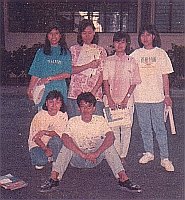He has always been a rebel. Or, as a Hogwarts professor described him, a non-conformist. Perhaps they are right. He did not always fit in (would not let himself fit in would be more appropriate). And he was like that long before Hogwarts.
The vision came slow. First, it was in the form of a funny feeling that something should be changed but don’t know what and how. A Hogwarts professor of the “dark arts*” was thrown off the air when Kimat T. Amianan defiantly waved his wand in support of mutineering musketeers in December of ‘89.
That funny feeling was later “clarified” by his fraternity with the scribes of Hogwarts and their higher orders. He was introduced to the heady prophecies of The-Man-With-A-Beard-Like-Hagrid then later to a great Chinese master who was fond of doing great marches, taking great leaps, and smelling a thousand flowers bloom.
Afterwards, he began seeing numbers in the guava leaves and spider cocoons. There is something in these but he can’t get it. So on a hot July day of 1990, Atlas shrugged and in the following chaos, strangers from far away suddenly appeared. Through them, Kimat T. Amianan began to understand his powers of divination.

Things have never been so clearer after that. Kimat T. Amianan can see into the future. And he discovered one thing: bilog ang mundo!
Profile: Church of Padre Garcia, Batangas
What is now the town of Padre Garcia was once known as Rosario. It was first established as an ecclesiastical mission of the Augustinian Recollects in 1776. The town and the parochial buildings were razed during the Philippine-American War. As such, the seat of government was moved to the present day town of Rosario. The abandoned town became known as Lumangbayan which the Oblates of St. Joseph started to ecclesiastically administer in 1928. They probably reconstructed the church that was again burned down during World War II and subsequently rebuilt again. Lumangbayan was given its present name in honor of a native son --- Padre Vicente Garcia.

*political science
The vision came slow. First, it was in the form of a funny feeling that something should be changed but don’t know what and how. A Hogwarts professor of the “dark arts*” was thrown off the air when Kimat T. Amianan defiantly waved his wand in support of mutineering musketeers in December of ‘89.
That funny feeling was later “clarified” by his fraternity with the scribes of Hogwarts and their higher orders. He was introduced to the heady prophecies of The-Man-With-A-Beard-Like-Hagrid then later to a great Chinese master who was fond of doing great marches, taking great leaps, and smelling a thousand flowers bloom.
Afterwards, he began seeing numbers in the guava leaves and spider cocoons. There is something in these but he can’t get it. So on a hot July day of 1990, Atlas shrugged and in the following chaos, strangers from far away suddenly appeared. Through them, Kimat T. Amianan began to understand his powers of divination.

Things have never been so clearer after that. Kimat T. Amianan can see into the future. And he discovered one thing: bilog ang mundo!
(End)
Profile: Church of Padre Garcia, Batangas
What is now the town of Padre Garcia was once known as Rosario. It was first established as an ecclesiastical mission of the Augustinian Recollects in 1776. The town and the parochial buildings were razed during the Philippine-American War. As such, the seat of government was moved to the present day town of Rosario. The abandoned town became known as Lumangbayan which the Oblates of St. Joseph started to ecclesiastically administer in 1928. They probably reconstructed the church that was again burned down during World War II and subsequently rebuilt again. Lumangbayan was given its present name in honor of a native son --- Padre Vicente Garcia.

*political science



















































